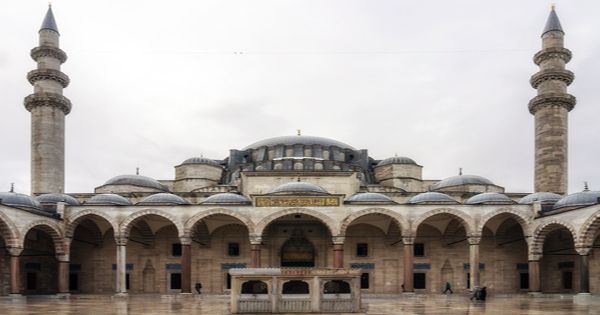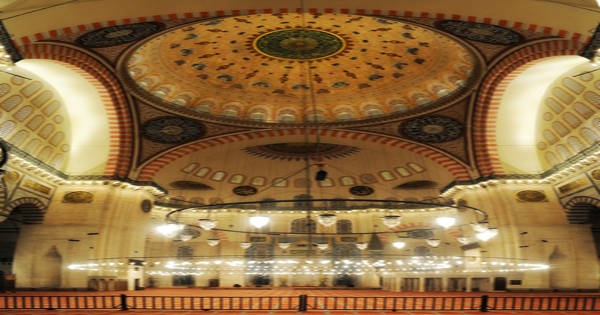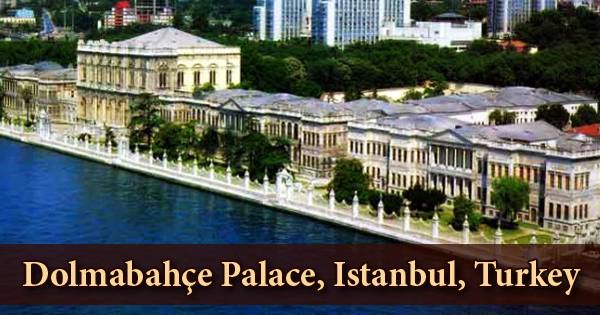One of the most significant cultural heritage buildings situated on the Third Hill of Istanbul, Turkey, is the Süleymaniye Mosque (Turkish: Süleymaniye Camii, Turkish pronunciation: sylejˈmaːnije). It is the largest in the city of Istanbul and also boasts of one of the best-known panoramas in the city. It is an imperial Ottoman mosque, and Suleiman the Magnificent commissioned the mosque, designed by the imperial architect Mimar Sinan (the greatest architect of the Ottoman Empire). An inscription shows the date of the foundation as 1550 and the date of the inauguration as 1557. It is also one of the most significant Ottoman-era structures. Near to the Spice Bazaar and the Grand Bazaar is the mosque.
There is an enclosure behind the mosque’s qibla wall containing the separate octagonal mausoleums of Suleiman the Magnificent and that of his wife Hurrem Sultan (Roxelana). The Süleymaniye Mosque was the biggest mosque in the town for 462 years before it was surpassed by the Çamlıca Mosque in 2019. Dedicated to Prince Mehmed, with the participation of all state organs, the mosque was completed. Suleiman the Magnificent commissioned it. As a testament to its sturdy construction, the public called it the “mosque that will remain forever”. It is the ideal example of Sinan as an architect’s creativity. Not only was the mosque the representative of a greater moral ideal, but it also functioned as a learning den. It is understood to have been used in its time as a social complex. The Süleymaniye Mosque is one of Istanbul’s best-known sights, and it commands a stunning view of the city around the Golden Horn from its spot on the Third Hill.

(North facade with the forecourt and the central fountain)
Although the mosque is known as Sinan the Architect’s masterpiece, the master himself called it “my work as a mere journeyman.” When designing the mosque, he thought it through to the finest detail. The four Süleymaniye Mosque minarets represent the four sultans who, after the conquest of Constantinople, took the throne. While the ten balconies on the minarets refer to the 10th Ottoman sultan being Suleiman’s. The inscription of the Arabic foundation above the north portal of the mosque is carved on three marble panels in Thuluth script. It gives a date of foundation in 1550 and a date of the inauguration in 1557. In fact, the mosque’s planning started before 1550, and parts of the complex were not finished until after 1557.
The visitor is struck by the elegance of the hand-loomed carpet, absolutely white, upon entering the mosque itself, except for the repeating pattern of a single niche covering the vast expanse of floor. Custom-made, in the 1950s the carpet was installed. On account of the lovely 16th century Iznik (Nicaea) glazed revetment tiles with floral and foliated motifs, the visual focus is occupied by the niche indicating the direction of Mecca (south). The concept of the Süleymaniye also plays on the self-conscious representation of Suleyman as a “second Solomon.” It references the Dome of the Rock, which was built on the site of the Temple of Solomon, as well as Justinian’s boast upon the completion of the Hagia Sophia: “Solomon, I have surpassed thee!” Suleyman’s historical significance is claimed by the Süleymaniye, comparable in magnificence to the previous structures. The structure is however smaller in scale than the Hagia Sophia, its older archetype.

When entering the mosque, an environment of unpretentious plainness strikes one. Within, there are four separate columns, all carried from various locations around the world. Among these are Istanbul’s Vefa district and Topkapı Palace, as well as the Baalbek Temple and the City of Alexandria. The dome is 53 meters in height and 27.5 meters in diameter. In terms of natural lightening given through 32 windows, the mosque is perfectly built. Since it has great acoustics, from any corner, sounds can be heard. It is recognized that under the domes, it is those empty pots that partially explain why the acoustics are so strong.
In the great fire of 1660, the Süleymaniye was destroyed and was rebuilt by Sultan Mehmed IV. During the 1766 earthquake, part of the dome collapsed. Subsequent repairs destroyed what was left of Sinan’s original decor (recent cleaning has shown that Sinan experimented first with blue, before making red the dominant color of the dome). The courtyard was used as an arms depot during World War I, and when some of the ammunition exploded, another fire broke out in the mosque. It was not completely restored again until 1956. In 2013, the building of the Haliç Metro Bridge irreparably altered the view from the north of the mosque.
In 1557, however, Mimar Sinan opened the mosque, finishing it in seven years. The completion of St. Peter’s Basilica was long-awaited, but it was finished in 1626. Sultan Suleiman gave Mimar Sinan the honor of opening this wonderful piece of art at the opening ceremony of the mosque. The door of this great mosque was opened with a golden key and applause and prayers by Mimar Sinan, who complied with this order with reverence. The entrance to the mosque itself is, like the other imperial mosques in Istanbul, followed by a forecourt with a central fountain. Of a colonnaded peristyle with columns of marble, granite, and porphyry, the courtyard is of exceptional grandeur. Rectangular Iznik tile window lunettes decorate the northwest facade of the mosque. The mosque is the first building where the brightly colored tomato red clay under the glaze contains the Iznik tiles.

(Interior looking towards the mihrab)
The tombs in the Süleymaniye Mosque courtyard belong in Ottoman society to dignitaries or renowned public figures such as Asiye and Rabia Sultan, Ahmed the Second, Suleiman the Magnificent, Hurrem Sultan, and Sinan the Architect. The four minarets are located at the four corners of the courtyard. There are three galleries (serifes) in the two taller minarets and they rise to a height of 63.8 m (209 ft) without their lead caps and 76 m (249 ft) with the caps. For mosques endowed by a sultan, four minarets were used (princes and princesses could construct two minarets; others only one). There are a total of 10 galleries in the minarets, which historically means that Suleiman I was the 10th Ottoman sultan. The main dome is 53 meters (174 feet) wide and has a diameter that is precisely half the height of 26.5 meters (86.9 feet).
The complex includes 6 schools, a medical school, a public bath, a soup kitchen, a hospice, shops, and a caravan and stables, in addition to the mosque. It is possible to access the Süleymaniye Mosque via three separate doors situated in its three parts. The mosque’s fountain courtyard welcomes tourists. The mosque’s interior is almost square, 59 meters (194 feet) long and 58 meters (190 feet) wide, creating a single vast space. In terms of the golden ratio, the mosque also stands out. The golden ratio yields a value of 1.618 if the distance is divided by height. With its marvelous features, the fountain in the middle of the courtyard stands out. The white marble mihrab and mimbar are also simple in nature, with simple ivory and mother of pearl designs, and woodwork is limited.
There are two mausoleums in the courtyard behind the main portion of the mosque where Suleiman the Magnificent and his wife Hurrem and their daughter Mihrimah are buried. The tomb of the architect Sinan lies just outside the mosque walls, to the north. In 1922, it was fully rebuilt.
Information Sources:
















